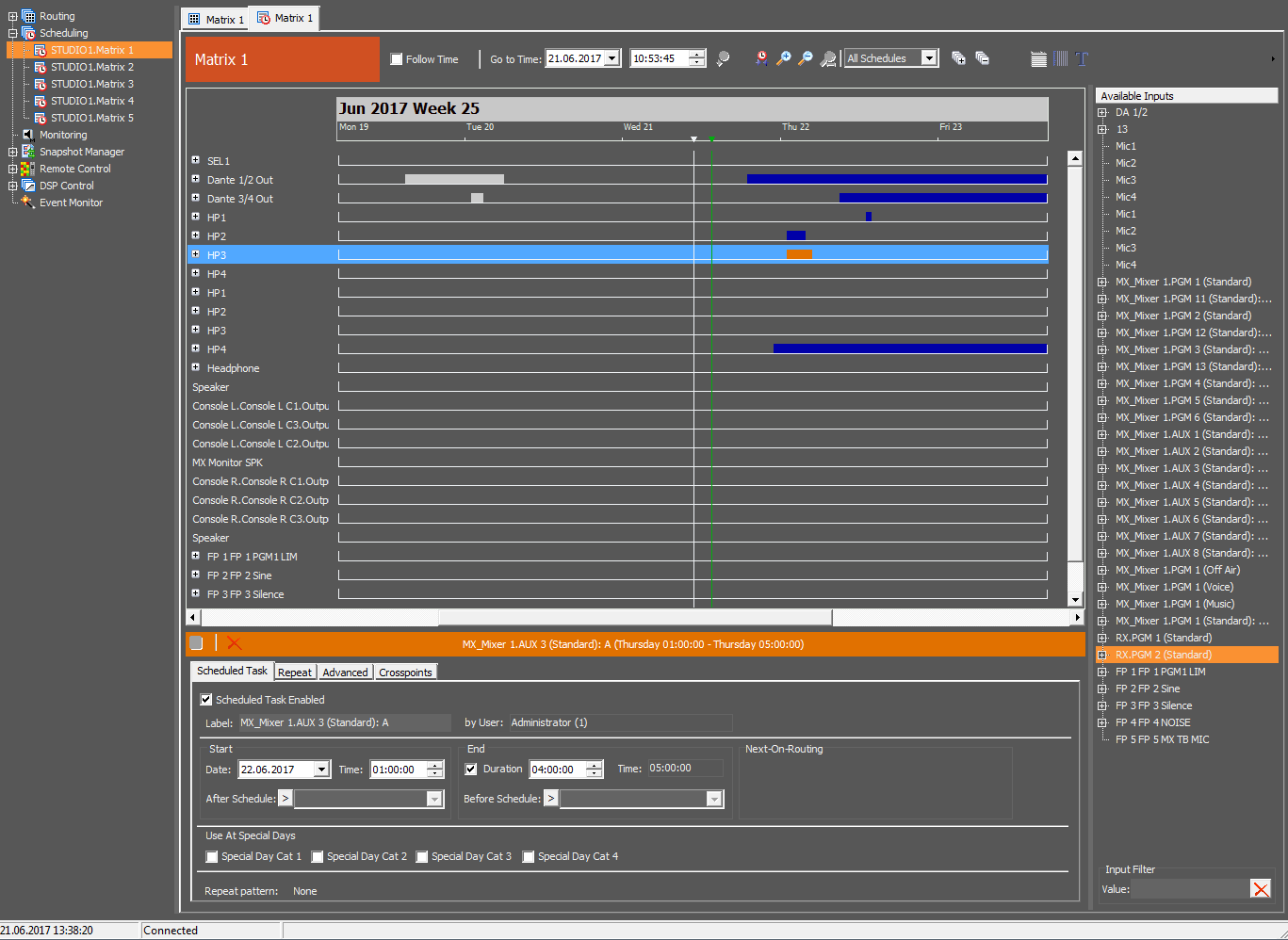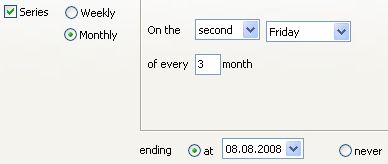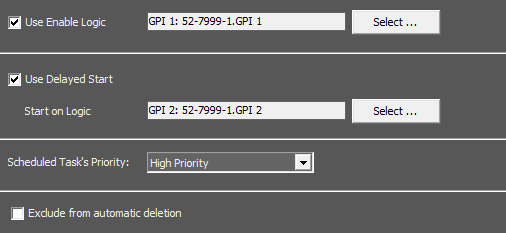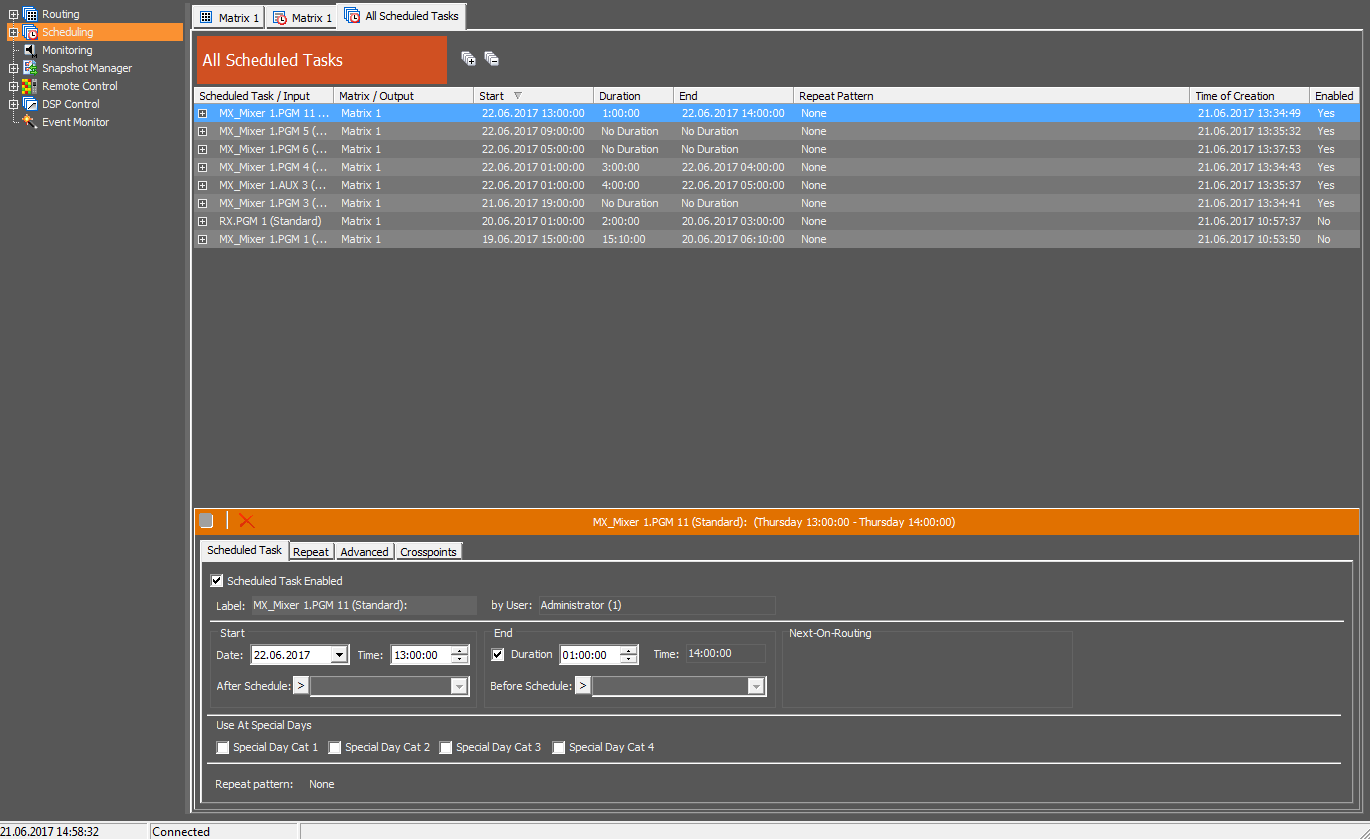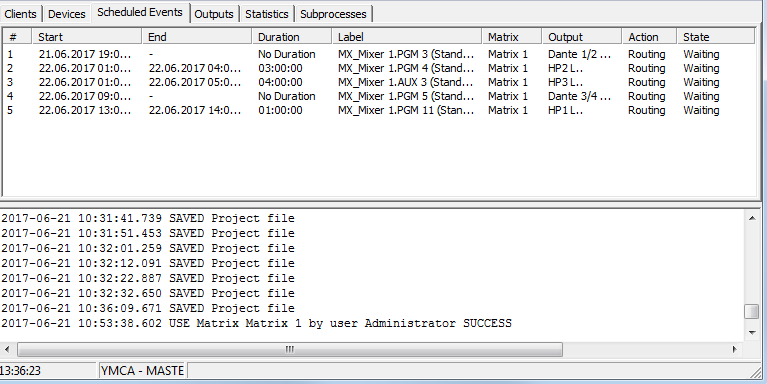Scheduling - Time Triggered Routing
The DHD Operation Manager (DHDOM) offers a number of functions to automate crosspoint routing. These routings are executed by the DHDOS at the configured date and time. Hence, the DHDOM only needs to be opened for the configuration process.
Double click a matrix in the Scheduling branch to open the timeline of this matrix. For a better work flow, it is possible to open several matrices at once in different tabs to quickly switch between them.
The scheduling option can be used for each matrix, provided the logged in user is allowed to use the scheduler. The number of Scheduled Tasks is not limited. Each scheduled task and its repetitions (scheduled events) are displayed via a separate elements in the timeline.
To create a time triggered crosspoint, you have to drag'n'drop the inputs from the list Available Inputs to the outputs of the timeline. This way you can overwrite the source of existing tasks, too.
Note
New inserted scheduled tasks that will become active within a certain time can be disabled by default, depending on the Global Options settings (see Global Options / Scheduler Options). The factory setting is: “Disable new scheduled task if it would be started within next 5 minutes”.
Inactive events are displayed in gray if the color settings of the DHDOM are not changed.
Please see Scheduler Options for further functions.
Choose the desired event with the mouse to be able to edit it. Afterwards four tabs are shown below: Scheduled Task, Repeat, Advanced and Crosspoints.
Note
Scheduled tasks can only be edited by users with the same or a higher priority than the user who has created the task.
In the Text View additional filter options are provided. Below the list including the scheduled events, you can enter input and output names or parts of these names to hide events that are currently not of interest.
Scheduler Views
The scheduler comes with three different views: Timeline, Timeplan and Text View. They can be switched using the  view buttons on the upper right-hand side.
view buttons on the upper right-hand side.
The Scheduled Task Tab
On the Scheduled Task tab you can enter a distinctive name for the task, set the date and time the task should start and enable or disable the complete task. Deactivate the Duration checkbox to create an endless scheduled event. Otherwise you have to choose the Duration and the end is calculated automatically.
The After Schedule functionality allows performing this routing when another schedule was disconnected.
With the Special Days checkboxes, you can define whether the task should be executed on Special Days (the desired Special Day Categories need to be activated) or not. (See Special Days)
Repeat Tab
Swap to the Repeat tab if you want to configure a repeat pattern for this task. In the upper section the repetition within a day can be configured. Select the checkbox to activate the repetition, choose a time interval between the repetitions and define how long the process should be repeated. Please notice, that the interval needs to be longer then the duration of the task, because the interval characterises the time between the beginning of the event until the beginning of the repetition.
You can activate a weekly or monthly repetition in the lower section of the Repeat tab.
Select the checkbox Series to activate the repetition and choose the desired interval (Weekly or Monthly). Within the weekly repeat pattern, the days of the week need to be selected, to define the repetitions of the task and whether this should happen every week or with an interval of a certain number of weeks. The configuration can be proceed without a defined end or until a concrete date.
If you have selected the monthly repetition, the task is repeated on specific week days in the chosen months, e.g. on every second Friday of every third month. The configuration can be proceed without a defined end or until a concrete date.
Advanced Tab
For dependent execution, on the Advanced tab you can define a logic source that needs to be true, otherwise the scheduled task is not executed. Therefore, activate the Use Enable Logic checkbox and click the Select button to assign a logic source.
Furthermore, you can set the Scheduled Task's Priority from normal to high. But this schedule priority is only important, if the user priority is identical. More important is the user priority (see Overlapping Scheduling Events).
The Use Delayed Start option allows to trigger the scheduled routing by a console logic. When the ckeckbox is enabled and the logic is selected, the schedule will become active on the designated time, but will not be executed unless the Start Logic is triggered.
In case that scheduled tasks are deleted automatically after a certain time (see Scheduler Options), it is possible to exclude each task from this process by activating the Exclude from automatic deletion option.
All configured tasks can be displayed in a list. For this, you have to double click the Scheduling branch itself in the left-handed list. The All Scheduled Tasks tab appears. Select an entry of this list to edit a task.
The list of scheduled tasks can be sorted by each available attribute (e.g. Duration, Time of Creation etc.) ascending and descending. Therefore, click the heading of the desired column.
On the Scheduled Events tab in the DHD Operation Server (DHDOS), you can find which events are currently active and which are upcoming next.
Crosspoints Tab
The Crosspoint Editor allows changing the crosspoints in dependance of the scheduled task. Crosspoints can be added by pressing Add, deleted by pressing Delete and edited by selecting the designated crosspoint in the list and pressing Select Input and Select Output.
The Crosspoint Editor list behaves mono.
